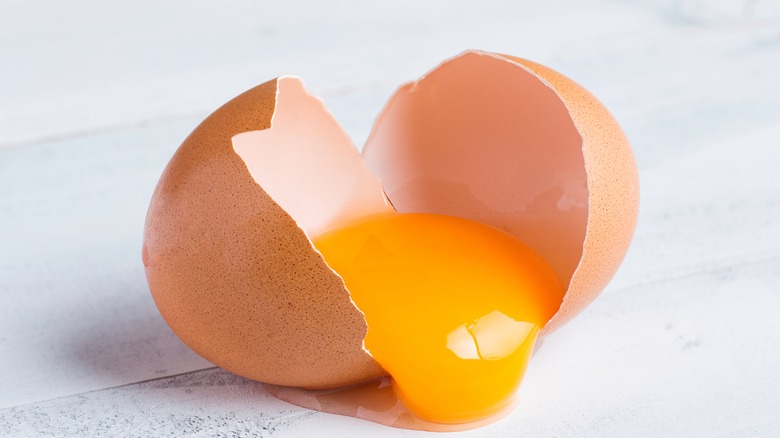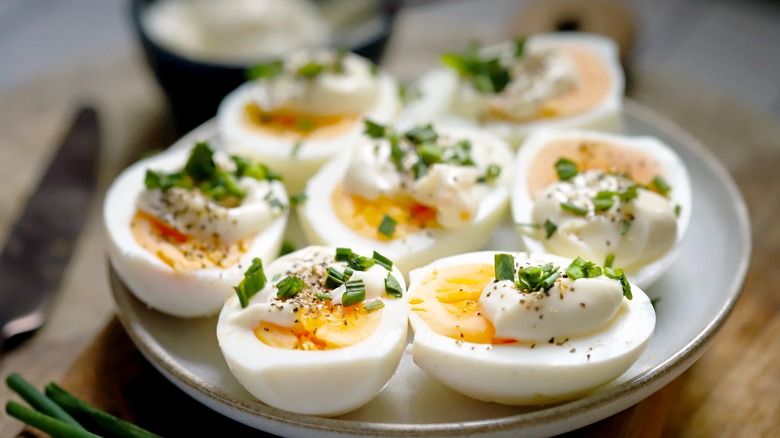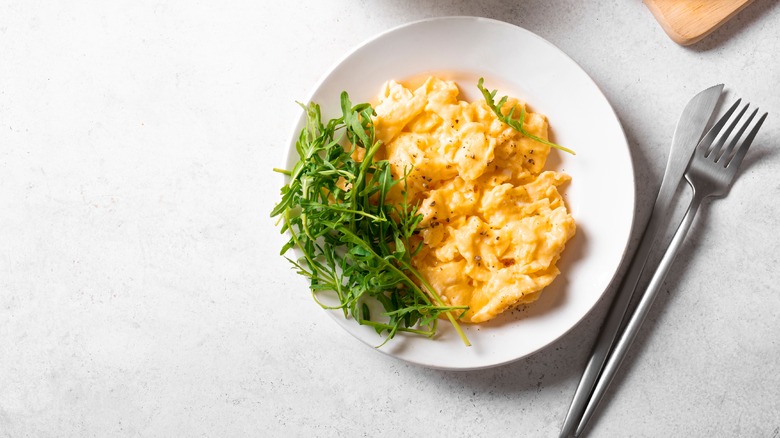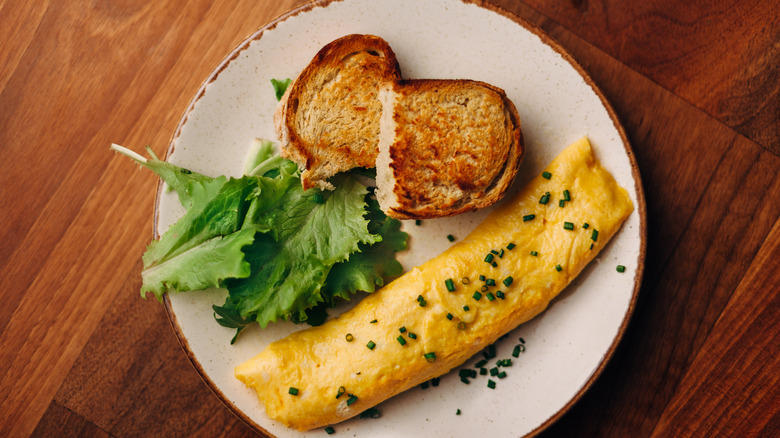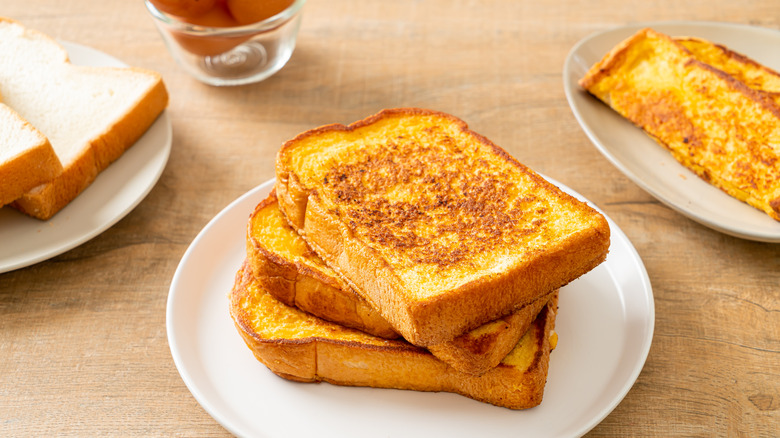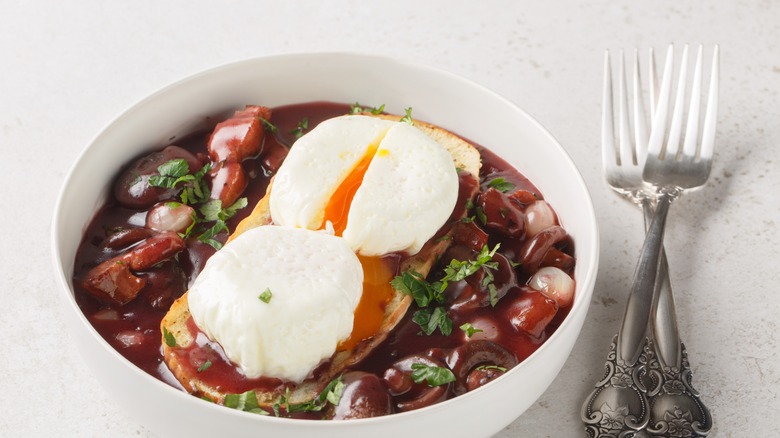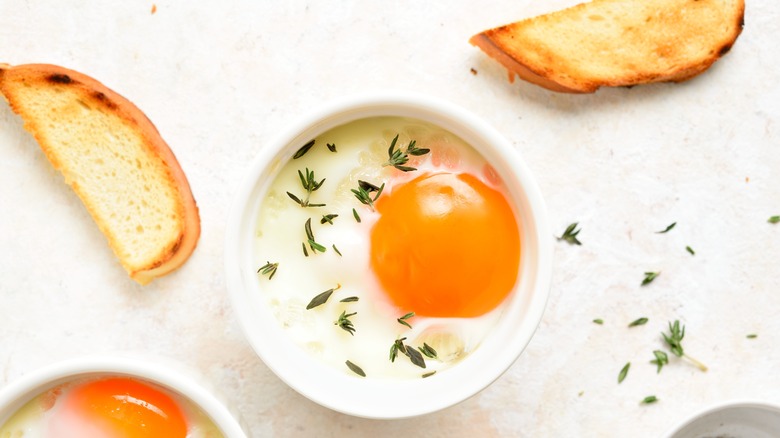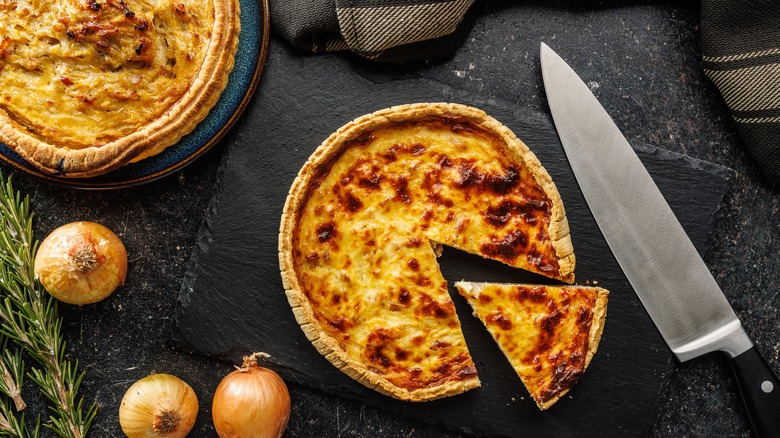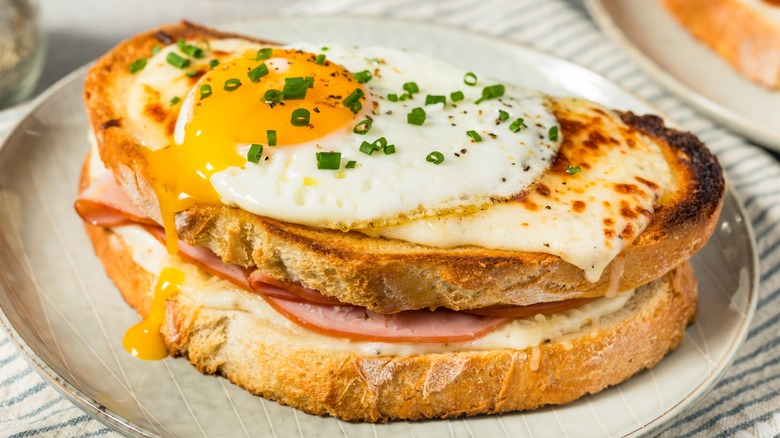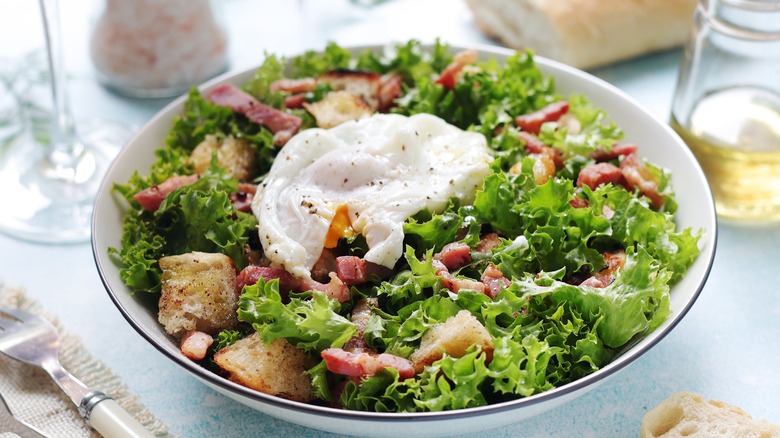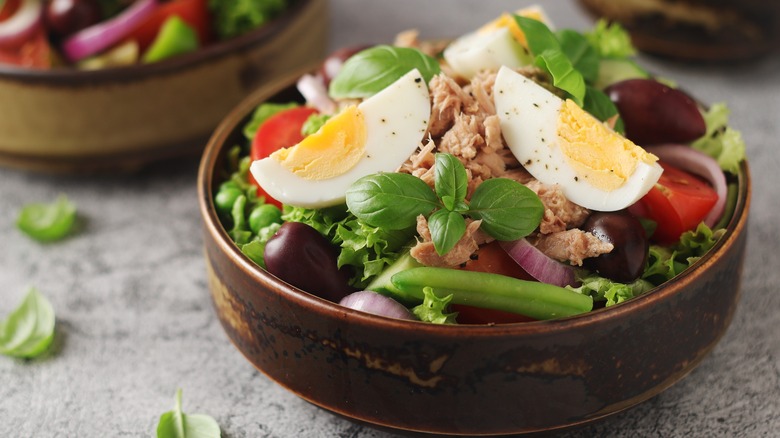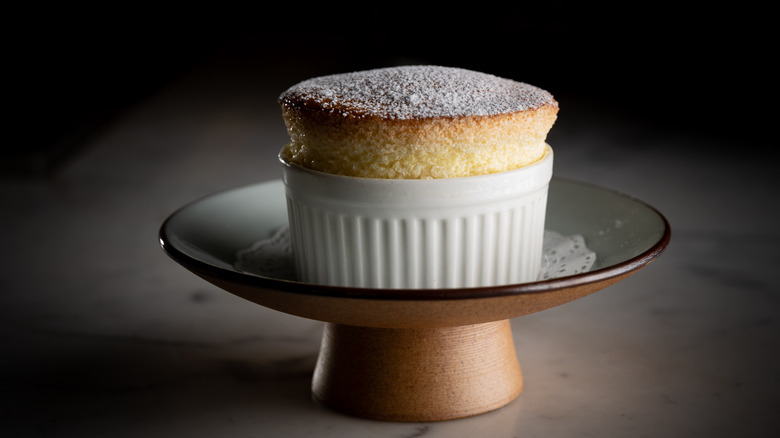French Egg Dishes You Need To Try At Least Once In Your Life
France's cuisine is nothing if not extra, from flambés to fricassés, and boasting more than enough rich sauces to make your cardiologist pass out. But while the French dishes that come to the minds of most are usually the showstoppers, such as crêpes suzette or sole meunière, it turns out French chefs are also blessed with a particular talent for transforming even the humblest of ingredients into something extraordinary.
Take, for example, the egg. A stalwart staple of kitchens around the world, eggs are a simple, relatively inexpensive protein source that is quickly transformed into a straightforward meal. But in the hands of a French chef, eggs get major star treatment. From the wow-worthy appeal of eggs drowning in a red wine sauce or set in aspic, to the technical acuity that makes simple creations like egg-mayonnaise or omelets so special, here are the French egg dishes you'd do well to get to know.
Egg-mayonnaise
Egg-mayonnaise is little more than the sum of its namesake parts — eggs and mayonnaise — and yet it's such a beloved bistro staple in France that an association has been established to protect it and awards a prize to the best egg-mayonnaise each year. Suffice it to say, people have got strong opinions about what makes egg-mayo magnifique.
A good egg-mayonnaise should, of course, be made with homemade mayonnaise, preferably one that's been generously spiked with Dijon mustard. The mayonnaise should be applied generously to three halves of hard-boiled egg, which are typically placed face-down on the plate, though some chefs put them face-up to show off the yellow yolks.
The eggs themselves can be a point of contention, as the perfect hard-boiled eggs often are. While most agree that the ideal hard-boiled egg should be fully set but never chalky — and certainly not without a grey ring around its center indicating serious overcooking — experts are divided on how to get there. Start in cold water or water that's already boiling? Cook them at a full boil or merely let them sit in the boiled water? Most pro chefs prefer to bring the water to a boil before adding the eggs and then cooking them at a full boil, as this method is more fool-proof, regardless of how many eggs you're cooking. But feel free to experiment at home to get the œuf parfait you desire.
Œufs brouillés
French œufs brouillés are so much more than a fancier (and far more difficult) way of saying scrambled eggs. For one, œufs brouillés are not a breakfast food. The French are famously fans of a small, sweet breakfast, with eggs relegated to lunchtime or even a quick-and-easy dinner. And that's not the only factor separating them from an American scramble.
In the U.S., scrambled eggs tend to be cooked fast and hot, diner-style, either on a flat-top griddle or in a frying pan. French œufs brouillés, on the contrary, require gentle coaxing to reach custardy perfection. Jamie Oliver cooks his over a bain-marie, for indirect heat that results in far moister curds of egg. Gordon Ramsay's scrambled egg technique is similar, requiring the cook pull the pan off the heat at times to keep the eggs from cooking too quickly. A touch of good French butter and crème fraîche make these eggs all the more luxurious.
Omelettes
Much like scrambled eggs, French omelets are a lunchtime food. But unlike œufs brouillés, which some may see as a scramble's more luxurious cousin, a French omelet is generally far more demure than the loaded diner omelets you'll find Stateside. While it is indeed sometimes filled, with mushrooms, cheese, or even topped with luxurious truffle, the most classic among them are seasoned simply with a blend of fresh herbs.
So what makes a French omelet stand out? The technique. As opposed to American-style omelets, French omelets are typically cooked gently on one side, until the interior is just barely set but still moist and baveuse (a word that literally translates to "drooling"), with the exterior still pale. At this point, the omelet is rolled around itself — a technique that requires a bit of dexterity to learn. Jacques Pepin shows viewers how to use a fork to bring up one edge of the omelet, at which point the handle of the pan should be banged slightly to bring the other edge in. It takes a bit of work to get it quite right, but practice will deliver the perfect, pillowy morsel of eggy goodness.
Pain perdu
In France, a French kiss is attributed instead to Florence, Italy, while French fries become simply pommes frites, meaning fried potatoes. Meanwhile French toast, a classic of brunch menus around the world, is known as pain perdu, or lost bread. The French name of this eggy, custardy marvel reckons with its roots in austerity: To take bread from the day before, so stale it was deemed "lost," and soak it in a custard to render it more palatable may well be one of the most delightful ways of getting around food waste we've ever seen.
There are far more dishes that fall under the term pain perdu than the recipe we think of as French toast. All that's required is to soak stale bread in an eggy custard. From there, it may be sweetened with sugar and vanilla or take on a savory slant, in the manner of a strata or savory bread pudding. While most French people making French toast at home start with whatever bread is hanging around in the bread box, you can make your pain perdu particularly luxurious by beginning with slices of buttery brioche or even day-old croissants.
Œufs en meurette
Lovers of the Burgundian classic known as beef bourguignon are sure to fall head over heels in love with œufs en meurette, a dish of poached eggs served in a similarly rich red wine sauce. The similarities between the two are no accident: Not only does œufs en meurette also hail from Burgundy, but it was likely a means of using up the rich, red wine gravy left behind after all of the beef had been eaten.
That said, you don't need to slow-simmer a beef stew to make œufs en meurette. Instead, a base of bacon, shallots, garlic, mushrooms, and pearl onions can be simmered in red wine and beef stock to lend some rich moreishness of the slow-cooked gravy. Once thickened, the sauce is topped with perfectly poached eggs. It's a dish best served in deep bowls or ramekins and accompanied with loads of crusty bread to soak up every last bite of that luscious sauce.
Eggs en cocotte
Eggs en cocotte could seem like a fancy way of saying baked eggs, but this French specialty stands out with to its reference to a cocotte — the baking vessel used to make the dish. A cocotte is an enamel-coated cast-iron pot with a lid. Given the ability of cast iron to retain heat, the cocotte is a particularly good vessel for slowly cooking eggs until they become creamy and luxurious, rather than set on the outside and still raw within. As compared to similar dishes like shirred eggs, œufs en cocotte also stands out in that it relies on an additional precaution to ensure you get the ideal texture: a water bath. As with other delicate mixtures, like cheesecakes, placing the cocotte in a water bath helps the eggs cook slowly and evenly.
You can flavor your eggs en cocotte with all manner of accouterments and toppings, from veggies to meat, but to reap the full textural benefits of this technique, simple may well be best: A bit of butter, some fresh herbs, a drizzle of cream ... and pourquoi pas a touch of cheese. We are in France, after all.
Quiche lorraine
Famously not pronounced "quickie," a quiche is a savory pie filled with a set custard, to which can be added all manner of fillings, from salmon and spinach to blue cheese and squash. But among quiches, perhaps the most famous is the quiche Lorraine, hailing from the French Lorraine region, on the border between France and Germany. The pie likely got its start as a humble farmstead dish, made with ingredients most farmers would have had on-hand: Eggs, cream, and bacon. While these days, some add cheese, this technically isn't a part of the original recipe, and traditionalists tend to eschew it.
If the quiche has expanded so far outside of its region of origin, we have refugees to thank. During the Franco-Prussian war in the 19th century, many locals of Lorraine fled the region in favor of Paris, bringing with them all sorts of local recipes from sauerkraut to beer. Once in the capital, they opened brasseries (the French word for brewery), which today have come to be known for serving hearty fare, including quiche.
Croque madame
A croque monsieur is a bistro classic par excellence. This French-style grilled cheese places ham and cheese between two slices of bread — typically classic sandwich bread, although some prefer sourdough, like the kind made from three-generations-strong Parisian bakery Poilâne. Béchamel sauce is generously slathered on top of the sandwich, which is topped with even more grated cheese before being broiled until crispy and browned.
The croque madame, meanwhile, takes things one step further and gilds the already rich lily with a perfectly fried egg. As for how it came to be known as a madame, the egg is said to resemble a wide-brimmed hat — the sort of hat ladies wore at the turn of the 20th century, when the sandwich first began showing up on menus. Once the yolk of the egg is pierced, it becomes a second sauce for the sandwich, which is perfectly paired with Dijon mustard to balance out the double dose of richness.
Salade Lyonnaise
Even French salads are extra, as the delicious concoction known as the salade Lyonnaise proves well. This salad is technically a member of the salade composée category, seeing as in France, une salade contains one main ingredient: salade aka lettuce. A "composed" salad, meanwhile, can contain multiple components. This one, as its name suggests, hails from Lyon, perhaps France's foremost culinary capital — especially insofar as it concerns charcuterie. It should come as no surprise, then, that it contains quite a bit of bacon in addition to the bitter frisée lettuce that lends it its other name, frisée-lardons, with lardon referring to the matchsticks of bacon.
While the egg isn't in the title of this recipe, it's an essential component uniting the other elements. The salad is crowned with a perfectly poached egg, so that when the yolk breaks, it emulsifies with the mustardy vinaigrette to coat every leaf of sturdy, bitter frisée. It's no surprise that Stateside, where savory breakfasts are the norm, it's a firm contender for king of the breakfast salads.
Salade Niçoise
Another classic French salade composée, this time hailing from Nice, is the salade Niçoise — and purists might gripe with it being included on this list. Indeed, in its purest form, a salade Niçoise contains very few of the ingredients most cooks have come to associate with it, from potatoes to green beans to eggs. Indeed, the original salade Niçoise was made with just three ingredients — tomatoes, anchovies, and oil — though it was not this version that Renée Graglia, former president of the Cercle de la Capelina d'Or which seeks to defend Nice's traditional recipes, defended tooth and nail. The Cercle's official recipe includes tomatoes, anchovies, tuna, olives, and basil, with an allowance for raw broad beans, artichokes or green peppers. But while it precludes the use of the potatoes that even Anthony Bourdain's salade Niçoise included, it does allow for hard-boiled eggs.
These days, most salade Niçoise recipes combine two kinds of fish — tuna and anchovies — with summer produce like tomatoes and green beans. Potatoes or rice might add bulk, and olives or red onion a lovely brininess. An olive oil dressing and a few quarters of hard-boiled egg complete the salad nicely.
Œuf en gelée
Oeuf en gelée may be a slightly old-fashioned recipe, but it's worthy of inclusion on this list thanks to how delightfully fussy it is. This dish of eggs set in aspic sees a soft-boiled egg set in beef jelly and paired with all manner of ingredients ranging from smoked ox tongue to ham to kale and mushrooms. It makes for a particularly pretty appetizer, especially when garnished with fresh herbs.
While you certainly can make œuf en gelée at home — and there's no shortage of French recipes showing you how to do just that — the reality is that most French people looking to enjoy this retro treat instead seek them out at a charcutier, a specialist in the art of cooked and cured meat you'll find all over France. Here, alongside more typical saucissons and pâtés, you'll find plenty of creations like œuf en gelée or pig's tongue terrine presented like the works of charcuterie art they are.
Soufflé
There may be no French egg dish more storied or epic than the soufflé. This dish, whose name comes from the French word souffle, meaning "breath," is a puff of airy egg made by beating egg whites to stiff peaks. When carefully folded into the batter, this technique introduces perhaps the most essential ingredient: air. The soufflés are then carefully baked until they have risen into eggy clouds, and they must be served immediately, lest they fall into a gooey mess.
Ostensibly invented by Paris' very first restaurateur in the 18th century, soufflés these days can be made in versions both savory and sweet. While the very first soufflé was apparently made with potatoes, today, lobster or cheese soufflés make the perfect main. A chocolate or classic Grand Marnier soufflé, meanwhile, is the ideal dessert, with the latter often served with a small glass of the orange-scented liqueur, which diners can pour into a small well created in the dessert with a spoon to impart even more flavor.
